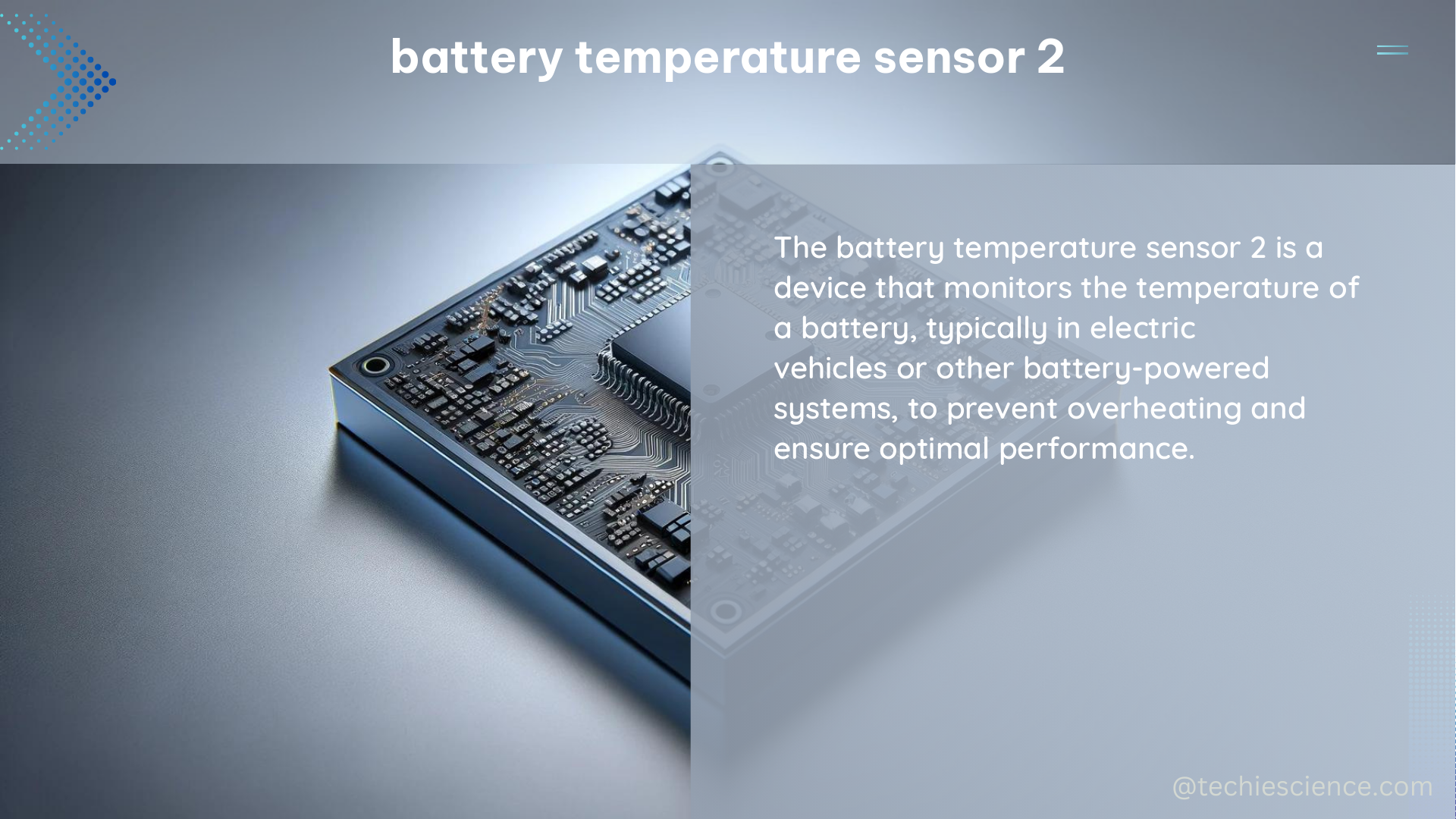The battery temperature sensor 2 is a critical component in battery systems, responsible for accurately measuring the temperature of the battery to ensure safe and efficient operation. This sensor plays a vital role in the battery management system (BMS), which monitors and controls various aspects of the battery, including temperature, voltage, and current.
Measurable and Quantifiable Data
The battery temperature sensor 2 typically provides temperature readings in degrees Celsius or Fahrenheit, with a range typically spanning from -30°C to 52°C. The sensor’s accuracy is crucial for the overall performance and safety of the battery system. According to the Battery Passport Content Guidance document, accurate temperature data is a key requirement for the battery passport, which serves as a comprehensive record of the battery’s lifecycle.
Sensor Response Time

The sensor’s response time is another critical factor, indicating how quickly it can detect temperature changes. A faster response time ensures more accurate temperature measurements, enabling the BMS to react promptly to temperature fluctuations and prevent potential issues. The response time of a battery temperature sensor 2 can vary, with some sensors capable of detecting changes in as little as 0.1 seconds, while others may have a response time of up to 1 second.
Sensor Calibration
Calibration is essential for maintaining the sensor’s accuracy. Regular calibration ensures that the sensor provides reliable temperature readings throughout its lifespan. The GSFC Technical Standard document provides guidelines for environmental verification programs, including calibration procedures for various components. For battery temperature sensors, the calibration process typically involves exposing the sensor to known temperature references and adjusting the sensor’s output to match the reference values.
Battery Health and Performance Monitoring
In addition to temperature measurement, the battery temperature sensor 2 can also provide valuable information about the battery’s overall health and performance. By monitoring temperature trends and variations, engineers can identify potential issues, optimize battery performance, and extend the battery’s lifespan. For example, sudden or unexpected temperature spikes may indicate a problem with the battery, such as a short circuit or a malfunctioning cell.
Sensor Placement and Integration
The placement of the battery temperature sensor 2 within the battery system is crucial for accurate temperature readings. Sensors are typically positioned in strategic locations, such as near the battery cells or the battery pack’s surface, to capture the most representative temperature data. The sensor’s integration with the BMS is also essential, ensuring seamless communication and data transfer for effective temperature monitoring and control.
Sensor Specifications and Standards
Battery temperature sensors are designed to meet various industry standards and specifications to ensure safety, reliability, and compatibility. Some key specifications to consider include:
- Operating Temperature Range: The sensor’s ability to accurately measure temperatures within the battery’s operating range, typically from -30°C to 52°C.
- Accuracy: The sensor’s ability to provide temperature readings within a specified tolerance, often within ±1°C or ±2°C.
- Resolution: The sensor’s ability to detect and report temperature changes in small increments, such as 0.1°C or 0.5°F.
- Sampling Rate: The frequency at which the sensor collects and reports temperature data, typically ranging from 1 Hz to 10 Hz or higher.
- Environmental Resistance: The sensor’s ability to withstand environmental factors, such as vibration, shock, and exposure to various fluids and chemicals.
- Compatibility: The sensor’s ability to integrate seamlessly with the battery management system and other components in the battery system.
Sensor Failure Modes and Troubleshooting
Like any electronic component, battery temperature sensors can experience various failure modes, such as sensor drift, short circuits, or complete sensor failure. In the event of a sensor issue, the BMS may trigger warning or error messages, alerting the user or the maintenance team to the problem. Troubleshooting may involve verifying the sensor’s connections, checking for physical damage, and performing calibration or replacement as necessary.
Conclusion
The battery temperature sensor 2 is a crucial component in battery systems, providing accurate and reliable temperature data to ensure safe and efficient battery operation. By understanding the sensor’s capabilities, specifications, and integration within the BMS, engineers and technicians can optimize battery performance, extend battery lifespan, and maintain the overall health of the battery system.
Reference:
- GUIDELINES FOR SAMPLING – DEQ NC: https://www.deq.nc.gov/ustsamplingchange-42022/open
- Battery Passport Content Guidance – Battery Pass: https://thebatterypass.eu/assets/images/content-guidance/pdf/2023_Battery_Passport_Content_Guidance.pdf
- Battery Testing, Analysis and Design – Department of Energy: https://www.energy.gov/sites/prod/files/2014/05/f15/APR13_Energy_Storage_e_IV_Battery_Tstg_Design_2.pdf
- Goddard Technical Standard GSFC-STD-7000B: https://standards.nasa.gov/sites/default/files/standards/GSFC/B/0/gsfc-std-7000b_signature_cycle_04_28_2021_fixed_links.pdf

The lambdageeks.com Core SME Team is a group of experienced subject matter experts from diverse scientific and technical fields including Physics, Chemistry, Technology,Electronics & Electrical Engineering, Automotive, Mechanical Engineering. Our team collaborates to create high-quality, well-researched articles on a wide range of science and technology topics for the lambdageeks.com website.
All Our Senior SME are having more than 7 Years of experience in the respective fields . They are either Working Industry Professionals or assocaited With different Universities. Refer Our Authors Page to get to know About our Core SMEs.